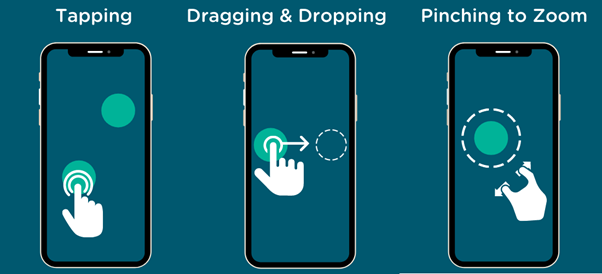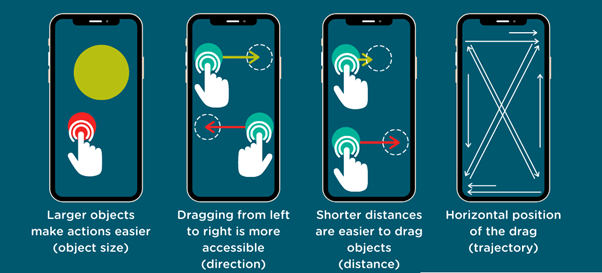Touching on Touchscreens - Making Technology More Accessible for People With Scleroderma
Are you reading this from a touchscreen device? Using touchscreen technology is something many of us do every day, without even thinking about it. But what happens to the people who have conditions that make touchscreens tough?
Touchscreens are everywhere. In daily life we use them all the time, and for the most part we don’t even realise it. Self-checkouts at the supermarket, ordering food at restaurants, buying a ticket at the train station, tracking your heart rate on a smartwatch or simply using your mobile phone. All these activities require a touchscreen. They need something else too… the ability to work that touchscreen; and it is here that many people with scleroderma face a challenge.
Hand disability affects a large proportion of people living with scleroderma; in fact it is often the first symptom of this condition and can be highly disruptive to a person’s daily life. In a study published in The Journal of Rheumatology, it was reported that 50% of women with scleroderma (from a cohort of 44, all living with lcSSc), were restricted in their professional working ability due to difficulty with dexterity and grip force. ‘Better working ability,’ which included taking less sick leave and performing better in a job role, was significantly correlated to both of those factors.
Scleroderma and Raynaud’s are both conditions which vary in severity and are experienced differently from person to person. The exact nature of someone’s hand disability is unique, as is the effect this has on their daily life. In the early stages of secondary Raynaud’s which typically precedes scleroderma, the most common symptom is puffy fingers. In later stages, digital ulcers and skin thickening impact the fingers – limiting a person’s dexterity. In addition, some people experience inflammatory arthritis, joint pain and swelling, which will further impair their mobility. Even when skin involvement in scleroderma is limited, the reduction in circulation to the hand that takes place can result in chronic swelling of the fingers, which causes reduced grip and a lower pinch strength. When combined, these factors can make holding and using a touchscreen device both difficult and frustrating.
What is being done?
Smartphones can be challenging to use, not only for people affected by scleroderma but for anyone with a hand disability. This has been known for a long time, but what had yet to be investigated was the question: ‘what exact issues with smartphone usage are people with scleroderma experiencing?’ A research team in Italy set out to answer this. Using 80 patients and 80 age and sex matched healthy controls, they quantified the challenges of touchscreen usage by asking participants to play three different games to test three distinct gestures: tapping, dragging/dropping, and pinching to zoom in.

The findings weren’t surprising – people with scleroderma were less successful at completing these ‘gaming’ tasks, taking longer to finish each game with more incorrect gestures in comparison to the control group. Of the three gestures, tapping was found to be the easiest and pinching-to-zoom was the one that showed the largest difference between the two groups. Dragging and dropping proved to be the most challenging of the three gestures for people with scleroderma. Within the drag-and-drop game, it was found that variables such as the distance across the screen an object had to be dragged, the size of the object being dragged and the horizontal position of the drag action all impacted performance.
It’s all in the design

The good news is that these findings do not exclude those with scleroderma from accessing mobile technology. The research revealed that moving larger objects around the screen caused a significant increase in the accuracy of movement and took less time when compared with moving smaller objects. Improvement was also seen when participants with scleroderma moved objects from the left to the right across the screen, rather than the other way around. The shorter the distance an object was dragged, the higher the accuracy for participants with scleroderma. This shows that simple changes in object size or direction of movement can make app usage easier and more accessible to people living with scleroderma.
Touchscreen training
Can we make touchscreens easier to use without changing the design of an app or a screen? Rehabilitation through targeted physiotherapy practice might make this possible. To investigate this, the research team identified the 10 users who experienced the greatest difficulty using touchscreens in the previous stage of the trial. They assigned them a physio-rehabilitation program to see whether practice could make perfect! For 30 days, each person played games moving through 10 increasingly difficult levels, with the aim of improving their hand function.
50% of the users found the physio beneficial for their hand function. Perhaps unsurprisingly, some users complained of hand fatigue! There was limited interest in continuing with training following on from the study, with most users stating that the amount of time they dedicated to completing the games three times a day was not feasible to continue outside of the clinical study period.
These results may seem obvious to those who struggle with touchscreens on a daily basis. For others however, this study gives an insight into a problem which they may have been unaware of. As well as providing clinical guidance for the development of ‘occupational therapy’ for SSc hands, these findings have ramifications for society as a whole: by indicating a need for touchscreen and app manufacturers to consider those with hand disabilities in the ever-growing array of ‘Smart’ products found within modern life. The good news is that thoughtful design and some minor adjustments can improve accessibility for all.
References
pdf-2.-Moroncini-Development-of-the-optimal-touchscreen-interface-for-patients-with-scleroderma.pdf (worldsclerofound.org)
